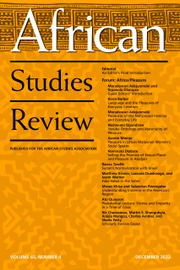In Projections of Dakar: (Re) Imagining Urban Senegal Through Cinema, Devin Bryson and Molly Krueger Enz explore creative and artistic works of Senegalese filmmakers who live and produce their art in Senegal. The filmmakers discussed include “Moussa Sène Absa, Rama Thiaw, Joseph Gaï Ramaka, Abdoul Azim, Cissé, Khady Sylla, Adams Sie, Khardiata Pouye, and Angèle Diabang” (43). When I first approached this text, I was curious to understand the choice of these filmmakers—why limit the study to this group rather than including Senegalese filmmakers in the diaspora? However, with keen attention to the methods and the arguments it became crystal clear that this choice was not a mere coincidence; rather, the authors seek to break the long-held frameworks of African and world cinema that often portray diasporic creatives and artists with access to international mobility. Also, the films selected respond to social inequalities and everyday challenges in the urban city of Dakar. These range from political failures, youth aspirations, migration, social injustice, gender, cultural continuity, and power.
What is particularly striking about this study is how the authors draw ideas from Frieda Ekotto and Kenneth Harrow’s critique of unequal cultural representation especially in African film and cinema discourses. They argue that “cultural capital that is possible within ‘African cinema’ or ‘world cinema’ is often unevenly distributed in favor of those filmmakers who are primarily situated outside of the continent or those who ‘qualify’ to pass borders in both directions more easily” (3). However, Projections of Dakar responds to this by focusing on Senegalese filmmakers who live and work in Senegal, which foregrounds local production conditions and creative practices that are often marginalized in global cinema discourses.
Bryson and Enz highlight how local and cultural productions also shape cinematic expressions. They position their analysis within the historical shift as described by Harrow from postcolonial engagement to a “post-engagement cinema” (3). This concept centers on internal urban crisis. Through the study of these twenty-first century documentary films produced in Dakar, the authors investigate the representation of the complexities of urban life by contemporary Senegalese filmmakers. Bryson and Enz, by focusing on Dakar not merely as a footnote but as a dynamic, ever-evolving “palimpsest city” (10) show how these films become both products and producers of urban culture. Their study contributes to a growing body of scholarship that reimagines African cities, particularly Dakar, as a space of cultural negotiation, political configuration, and aesthetic experimentation.
What foregrounds the relevance of this study is how the authors draw from the philosophical frameworks of Achille Mbembe and Felwine Sarr, particularly their work in the Ateliers de la pensée; they push for a coherent interpretation and understanding of African cities especially Dakar, as entangled with orbits of meaning. Thus, the films analyzed are shaped by the sociopolitical occurrences in Dakar. That said, they don’t project the city’s problems but respond to how African cities are viewed by the rest of the world. I find this very intriguing because films are mirrors of society and as such these films didn’t just show Dakar as full of poverty, hunger and inequalities but instead offer a more realistic picture. Bryson and Enz push back against the concept of “miserabilist paradigm” (14), which often views African cities through a lens of despair. With this intentionality, the authors shy away from presenting Dakar’s marginalization and inequality by drawing attention to these filmmakers who capture both the lived realities and experiences of exclusion and inclusive futures. By employing this approach, Senegalese urban cinema is portrayed not only as a visual collection of hardship but instead as a complex space where alternative urban futures can be imagined. The filmmakers in this book don’t just visualize the hardship, they imagine ways to navigate them and live together in cities. They suggest that African cities can be influenced by people’s everyday cultural creativity.
I am fascinated by the concept of “arts of citizenship” (15) which the authors draw from Mamadou Diouf and Rosalind Fredericks, to examine how Senegalese filmmakers employ their creative skills and sometimes informal ways to echo their voices and assert their place in the city. It is pertinent to note that these “arts” aren’t just about legal actions, but they include everyday creative gestures that help people feel a sense of belonging in the city even when they are not part of the official systems. What makes Projections of Dakar even more interesting is its grounding in long-term, on-ground research. The authors go beyond textual analysis by undertaking over a decade of ethnographic fieldwork and interviews. This approach enabled the authors to have an immersive look into Dakar’s cinematic landscape, homegrown film studios to distribution networks. This allowed them to show how Senegalese filmmakers adjust and respond to structural limitations with grassroots creativity as well as building systems to keep cinema culture alive and thriving in the city. Another important strength of this work is its attention to the everyday creative engagements of filmmakers working outside formal structures. Bryson and Enz highlight how these creatives navigate failures of systemic infrastructure as well as reflect the same resilience seen across Dakar’s urban population, especially in the face of systemic economic and social exclusions. The authors’ preference for documentary film, which is often undervalued in global cinema discourse, is significant. In addition, by focusing on documentary films, the authors show how it functions both as a storytelling device and a tool for activism, inclusion, and cultural intervention.
The book will appeal to scholars and students of African studies, film, and media as well as urban anthropology. Its focus on documentary films both as creative expression and civic intervention marks its vital contribution to understanding how storytelling intersects with everyday urban life. However, some readers may find some sections of the analysis overly detailed, especially when it veers into minor details that are tangential to the book’s central argument.

